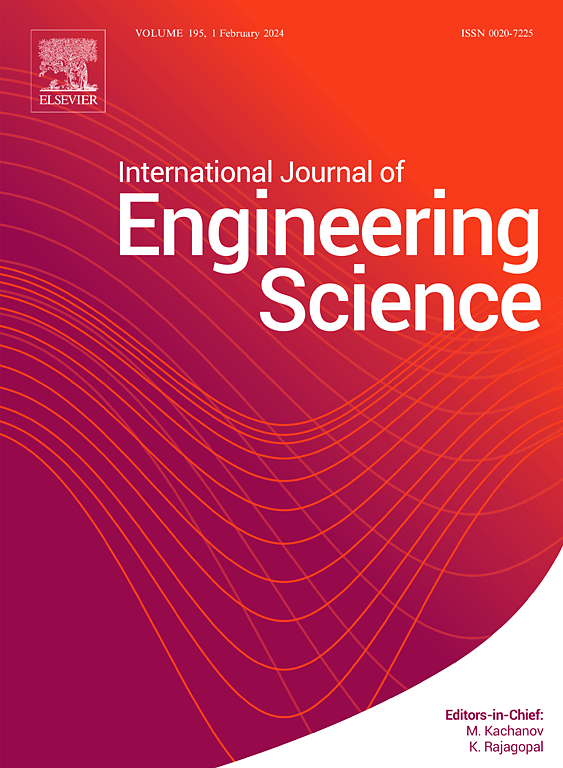考虑纤维弯曲刚度的纤维增强复合材料的电磁Cosserat谱建模
IF 5.7
1区 工程技术
Q1 ENGINEERING, MULTIDISCIPLINARY
International Journal of Engineering Science
Pub Date : 2025-08-11
DOI:10.1016/j.ijengsci.2025.104360
引用次数: 0
摘要
在这项研究中,我们开发了一个基于谱不变量的非线性框架来模拟纤维增强复合材料的电磁行为,明确地考虑了嵌入纤维的纤维刚度。采用Cosserat连续统理论,我们推导了应力和耦合应力的一般本构方程,这些本构方程捕捉了机械和电磁场之间的相互作用。这些方程还可以对耦合应力张量进行有物理意义的分解。为了模拟纤维弯曲起主导作用的材料,我们通过将其对纤维方向梯度的依赖限制为沿纤维轴的方向导数来改进一般本构方程。针对一般情况和特殊情况,提出了内能函数的原型形式。我们通过解决涉及纤维弯曲和膨胀的边值问题来证明专用模型的适用性,突出其物理相关性。研究结果为先进智能材料的设计和模拟提供了基础,特别是在电磁效应和纤维微观结构强耦合的应用中。本文章由计算机程序翻译,如有差异,请以英文原文为准。
On the electromagnetic Cosserat spectral modelling of fibre-reinforced composites with fibre bending stiffness
In this study, we develop a nonlinear framework based on spectral invariants to model the electromagnetic behaviour of fibre-reinforced composites, explicitly accounting for the fibre stiffness of the embedded fibres. Employing Cosserat continuum theory, we derive general constitutive equations for stress and couple stress that capture the interactions between mechanical and electromagnetic fields. These equations also enable a physically meaningful decomposition of the couple stress tensor. To model materials in which fibre bending plays a dominant role, we refine the general constitutive equations by restricting their dependence on fibre direction gradients to directional derivatives along the fibre axis. Prototype forms of the internal energy function are proposed for both the general and specialized cases. We demonstrate the applicability of the specialized model by solving boundary value problems involving fibre bending and inflation, highlighting its physical relevance. The results offer a foundation for the design and simulation of advanced smart materials, particularly in applications where electromagnetic effects and fibre microstructure are strongly coupled.
求助全文
通过发布文献求助,成功后即可免费获取论文全文。
去求助
来源期刊

International Journal of Engineering Science
工程技术-工程:综合
CiteScore
11.80
自引率
16.70%
发文量
86
审稿时长
45 days
期刊介绍:
The International Journal of Engineering Science is not limited to a specific aspect of science and engineering but is instead devoted to a wide range of subfields in the engineering sciences. While it encourages a broad spectrum of contribution in the engineering sciences, its core interest lies in issues concerning material modeling and response. Articles of interdisciplinary nature are particularly welcome.
The primary goal of the new editors is to maintain high quality of publications. There will be a commitment to expediting the time taken for the publication of the papers. The articles that are sent for reviews will have names of the authors deleted with a view towards enhancing the objectivity and fairness of the review process.
Articles that are devoted to the purely mathematical aspects without a discussion of the physical implications of the results or the consideration of specific examples are discouraged. Articles concerning material science should not be limited merely to a description and recording of observations but should contain theoretical or quantitative discussion of the results.
 求助内容:
求助内容: 应助结果提醒方式:
应助结果提醒方式:


